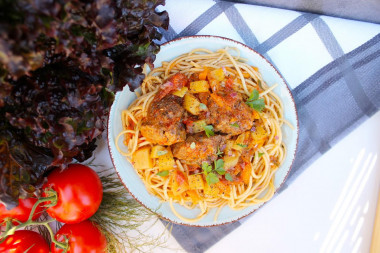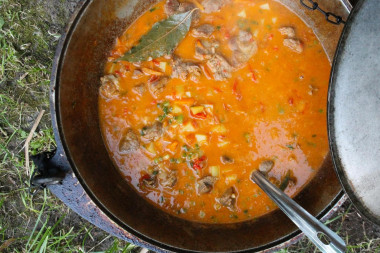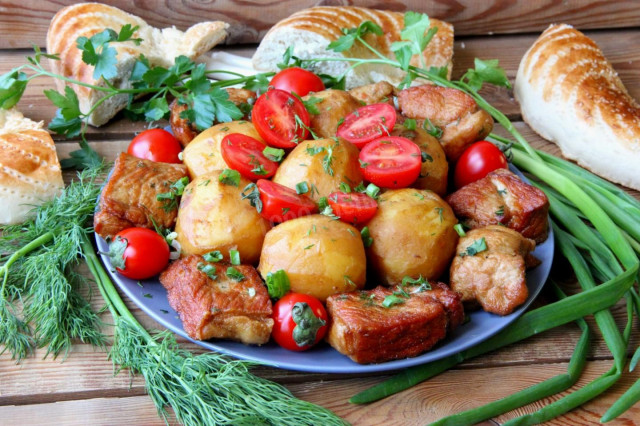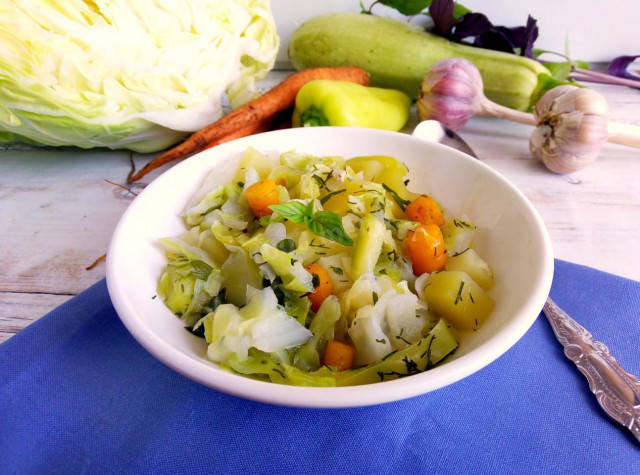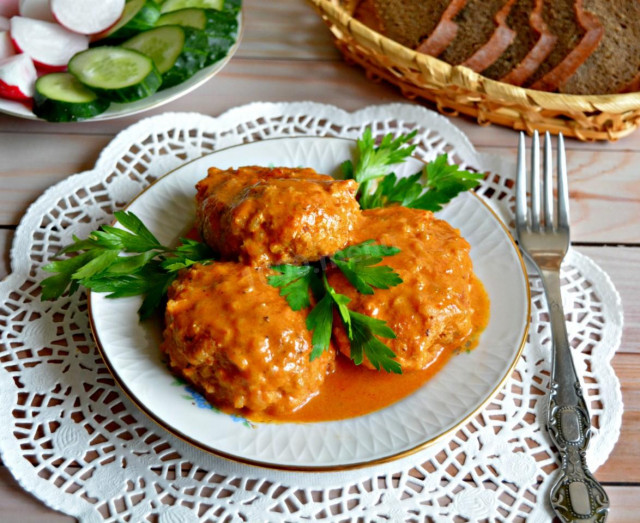Composition / ingredients
Step-by-step cooking
Step 1:

Prepare all the necessary products that you will need to cook lagman in a cauldron over a fire. The most delicious lagman, it seems to me, is obtained from beef, veal or lamb, pork, turkey or poultry meat can also be used. This time I took a piece of pork neck.
Step 2:
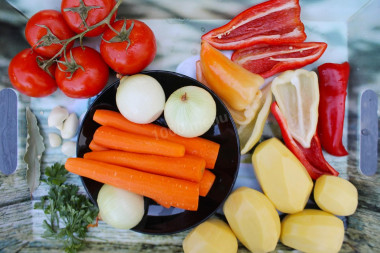
Peel potatoes, onions, carrots and garlic. Cut the bell pepper in half, remove the seeds and the core. Rinse all vegetables, including tomatoes, in clean water. Wash the potato tubers thoroughly with a brush or sponge in water to get rid of the remnants of earth and dirt.
Step 3:

Cut the onions and peppers into half rings or small cubes, as you are more accustomed to. Potatoes at this time it is better to pour cold water, otherwise there is a risk that it will darken.
Step 4:

Chop the carrot into cubes, or grate on a coarse grater.
Step 5:

Rinse a piece of meat in water and dry it with paper napkins. Cut the pork into small pieces (about the size of a matchbox).
Step 6:

Chop tomatoes into cubes or slices of small size.
Step 7:

Light a fire. Pour vegetable oil into the cauldron and wait for it to heat up. Keep the heat at maximum, as in the first stages of cooking, the products should be fried.
Step 8:
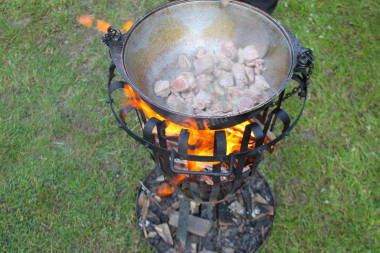
Send the meat to the cauldron and, stirring continuously with a slotted spoon, fry the pieces until a golden crust appears (this will take about 7-10 minutes, depends on how strong the fire is under your cauldron).
Step 9:
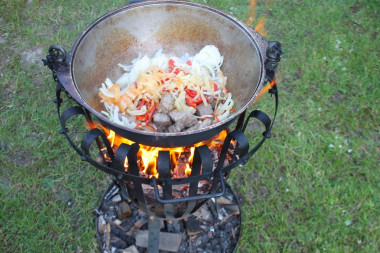
Then add Bulgarian pepper and onion to the meat, fry, constantly stirring the products, about 2 minutes.
Step 10:

Next comes the carrot queue.
Step 11:

Mix everything and cook for 5 minutes on high heat, so that all the vegetables are lightly fried.
Step 12:

Send tomatoes to the cauldron. Tomatoes are better to use seasonal, they are more fleshy, juicy and have a sweet taste.
Step 13:
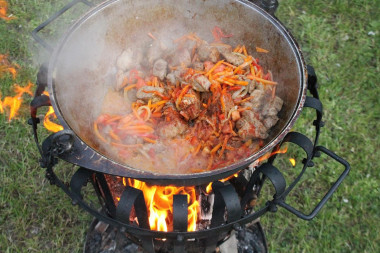
Salt the contents of the cauldron, as well as add your favorite seasonings. I used ground peppers, a little chili, half a teaspoon of hops-suneli and a pinch of cumin.
Step 14:
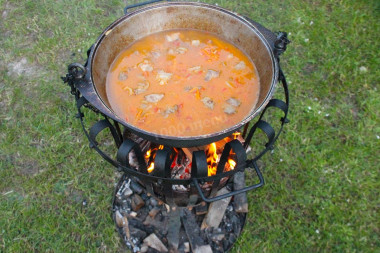
Fill the products with water, stir, after boiling, make the fire under the cauldron moderate and cook under a closed lid for about 40 minutes. Do not forget to throw firewood so that the fire does not go out.
Step 15:
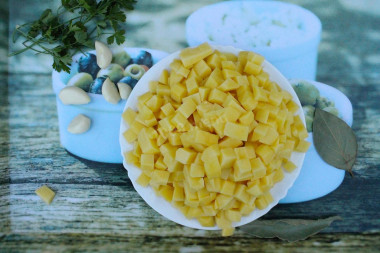
At this time, prepare the remaining ingredients. Cut the potatoes into the same medium-sized cubes (about 1cm by 1cm).
Step 16:
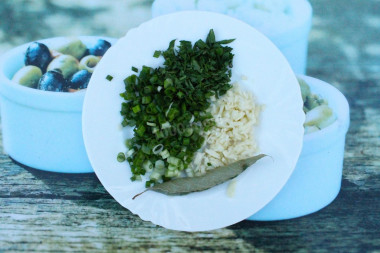
Chop the garlic with a knife as finely as possible, and cut the greens arbitrarily.
Step 17:
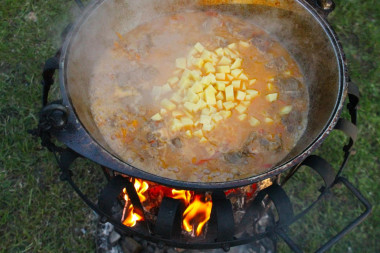
Add potatoes to the cauldron.
Step 18:
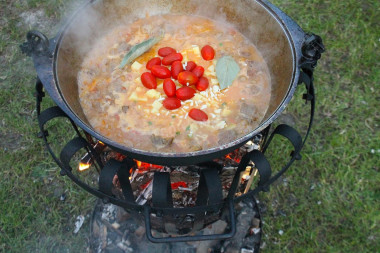
Then send the bay leaf and garlic. If I have cherry tomatoes available, then I usually also use them for cooking over a campfire. Optionally, you can add 1 tbsp.l. tomato paste.
Step 19:
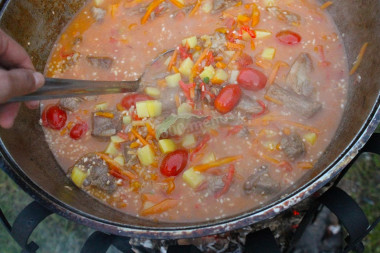
Mix the contents of the cauldron, taste for salt, if necessary, then add salt. If it seems to you that there is not enough liquid, then at this stage add the required amount of boiling water. Leave under a closed lid until the potatoes are fully cooked (about 20 minutes).
Step 20:

At this time, boil the pasta in a separate saucepan.
Step 21:

The finishing touches are left. Add the greens to the cauldron, the bay leaf can be fished out and thrown away. He has already fulfilled his function by giving his flavor to tomato broth.
Step 22:
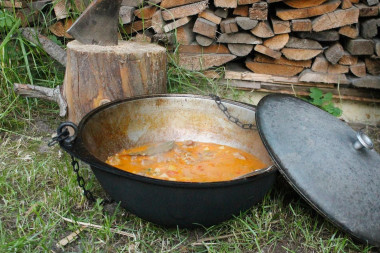
Remove the cauldron from the fire and let the dish brew for 10-15 minutes.
Step 23:
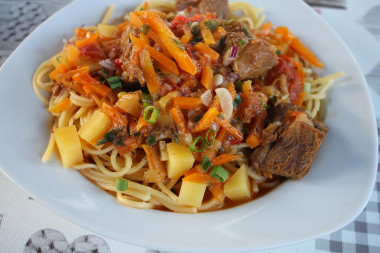
You can serve lagman in deep plates, in the form of a thick soup, adding more liquid to the noodles.
Step 24:
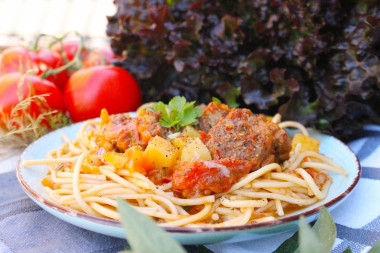
Either on flat plates as a hot second course.
Noodles on lagman can be made at home, but usually when I cook over a campfire, it is not very convenient to do dough and rolling, so in these cases I use ready-made pasta.
If there is no stove at hand to boil the pasta, then I throw the noodles straight into the cauldron at the stage when the potatoes are ready, leave them under the lid for 5 minutes, and then add the greens. In this case, a 2-in-1 dish is obtained.
Bon appetit!
Since the degree of salinity, sweetness, bitterness, sharpness, acid, burning is individual for everyone, always add spices, spices and seasonings, focusing on your taste! If you put some of the seasonings for the first time, then keep in mind that there are spices that it is especially important not to shift (for example, chili pepper).
How to cook pasta properly, how to cook pasta al dente, how to choose a quality product to avoid disappointment and much more, read the article "Pasta and pasta - the subtleties of choice and secrets of cooking" .
In addition to pork, any other meat can be used in this dish. Keep in mind that the cooking time, as well as the taste and calorie content of the dish will change. For example, beef is cooked longer than pork, and chicken fillet or turkey is less.
Caloric content of the products possible in the composition of the dish
- Onion - 41 kcal/100g
- Ripe potatoes - 80 kcal/100g
- Baked potatoes - 70 kcal/100g
- Mashed potatoes - 380 kcal/100g
- Boiled potatoes - 82 kcal/100g
- Potatoes in uniform - 74 kcal/100g
- Fried potatoes - 192 kcal/100g
- Tomatoes - 23 kcal/100g
- Pork fat - 333 kcal/100g
- Pork meat - 357 kcal/100g
- Pork - low-fat roast - 184 kcal/100g
- Pork chop on a bone - 537 kcal/100g
- Pork - schnitzel - 352 kcal/100g
- Pork shoulder - 593 kcal/100g
- Boar's leg - 113 kcal/100g
- Pork - 259 kcal/100g
- Sweet pepper - 27 kcal/100g
- Carrots - 33 kcal/100g
- Dried carrots - 275 kcal/100g
- Boiled carrots - 25 kcal/100g
- Pasta, premium grade, fortified - 337 kcal/100g
- Pasta, premium, dairy - 309 kcal/100g
- Pasta, premium grade, egg - 342 kcal/100g
- Pasta made from flour of the 1st grade - 333 kcal/100g
- Pasta made of flour in / with - 338 kcal/100g
- Boiled pasta - 135 kcal/100g
- Pasta - 338 kcal/100g
- Garlic - 143 kcal/100g
- Bay leaf - 313 kcal/100g
- Vegetable oil - 873 kcal/100g
- Salt - 0 kcal/100g
- Water - 0 kcal/100g
- Spices dry - 240 kcal/100g
- Fresh frozen soup greens in a package - 41 kcal/100g
- Greenery - 41 kcal/100g


